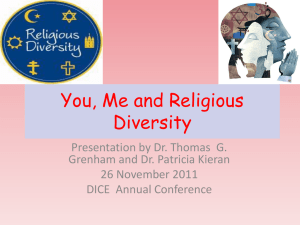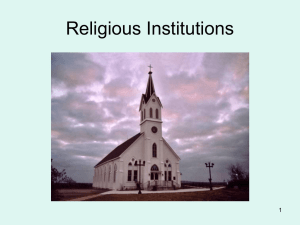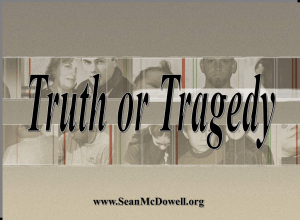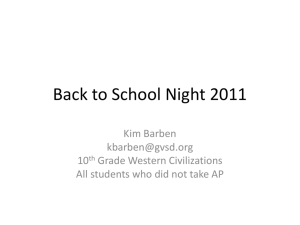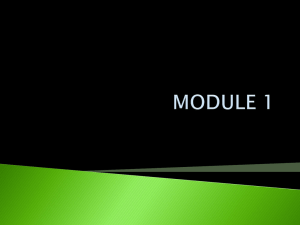2012 Religions of the Middle East Lesson Plan Dates: Essential and
advertisement
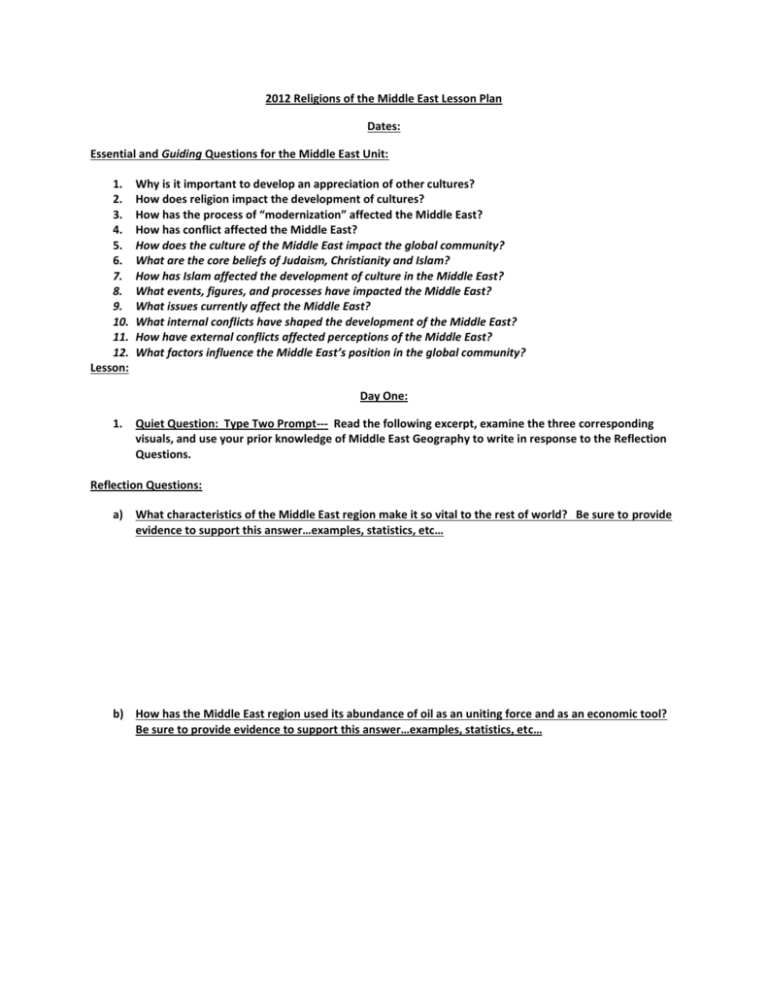
2012 Religions of the Middle East Lesson Plan Dates: Essential and Guiding Questions for the Middle East Unit: 1. 2. 3. 4. 5. 6. 7. 8. 9. 10. 11. 12. Lesson: Why is it important to develop an appreciation of other cultures? How does religion impact the development of cultures? How has the process of “modernization” affected the Middle East? How has conflict affected the Middle East? How does the culture of the Middle East impact the global community? What are the core beliefs of Judaism, Christianity and Islam? How has Islam affected the development of culture in the Middle East? What events, figures, and processes have impacted the Middle East? What issues currently affect the Middle East? What internal conflicts have shaped the development of the Middle East? How have external conflicts affected perceptions of the Middle East? What factors influence the Middle East’s position in the global community? Day One: 1. Quiet Question: Type Two Prompt--- Read the following excerpt, examine the three corresponding visuals, and use your prior knowledge of Middle East Geography to write in response to the Reflection Questions. Reflection Questions: a) What characteristics of the Middle East region make it so vital to the rest of world? Be sure to provide evidence to support this answer…examples, statistics, etc… b) How has the Middle East region used its abundance of oil as an uniting force and as an economic tool? Be sure to provide evidence to support this answer…examples, statistics, etc… c) What do you think will happen to the Middle East region when all of its natural resources are consumed in the next century or so? Why do you think that? The Modern Middle East: Oil and War Overview 2012 The Middles East is a complex tangle of conflicts. These are not just low-intensity struggles. Some of these wars have involved the biggest tank battles since the Second World War. There have been six such wars since 1945, and several civil wars. Such instability in a region would be alarming enough, but the Middle East supplies a significant portion of the world’s oil. Violence in the Middle East has an impact on the world’s oil supply. The Middle East has roughly two thirds of the world’s proven oil reserves. Proven oil reserve is oil in the ground, still down there to be pumped. Saudi Arabia has the most, with roughly 260 billion barrels. Iraq is second with about 100 billion barrels. Three other Middle Eastern states, Kuwait, Iran, and the United Arab Emirates, have over 90 million barrels of proven oil reserves. For comparison, North America, including Canada, the United States, and Mexico, has a total proven oil reserve of 80 billion barrels. This is the second biggest reserve after the Middle East. The Middle East sells oil to Japan, Western Europe, the United States, Canada, Australia, and some other countries. Oil is a vital commodity to each of these buyers. Since oil is often the most important export, the price of oil is a major concern to the Middle Eastern countries. OPEC, the Organization of Petroleum Exporting Countries, has most of its members in the Middle East. OPEC membership includes Algeria, Iraq, Kuwait, Libya, Qatar, Saudi Arabia, United Arab Emirates, Gabon, Indonesia, Iran, Nigeria, and Venezuela. The members have a variety of perspectives, but they try to control production to maintain stable prices. Transporting oil is itself a major business in the Middle East. Pipelines cross the area, passing through some countries that are not major producers themselves. There is a pipeline from Saudi Arabia through Jordan, Syria, and Lebanon to the eastern Mediterranean Sea. There is one from Iraq through Turkey to the eastern Mediterranean. Each producing country has its internal pipelines taking oil to ports or refineries. The waters around the Middle East are major oil transport routes. The Strait of Hormuz at the mouth of the Persian Gulf has about a quarter of the world’s oil passing through it. Some oil going to Europe from the Persian Gulf is shipped through the Red Sea and Suez Canal into the Mediterranean. These pipelines and waterways are vital supply lines to major oil importers. Ranking of Oil Reserves Country Billions of Barrels 1. Saudi Arabia 265.3 2. Iraq 115 3. Kuwait 98.8 4. Iran 96.4 5. United Arab Emir. 62.8 6. Russia 54.3 7. Venezuela 47.6 8. China 30.6 9. Libya 30 10. Mexico 26.9 11. Nigeria 24.1 12. United States 22 13. Algeria 12.7 14. Norway 10.1 15. Indonesia 9.7 16. Angola 9 17. Brazil 8.5 18. Oman 5.8 19. Canada 5.6 20. Qatar 5.6 (Adapted from: “Countries with Largest Oil Reserves.” Available URL: http://www.aneki.com/oil.html, 2006) 2. Class: Have students share responses. After discussing the importance of oil in the Middle East, introduce another reason for why the Middle East is so importance---its religious significance. Play the three minute film clip from United Streaming----Jerusalem and Three Faiths. 3. Class: Ms. Barben is going to begin her Three Faiths Overview Powerpoint, and you will take notes on the three faiths in the provided graphic organizer. 4. Homework: Read and Talk to the Text on the Supplemental Reading “Introduction to the Abrahamic Faiths.” You must download and print this up from Ms. Barben’s Teacher Page. Follow the step by step directions as outlined in the grading criteria below. 2012 “Introduction to the Abrahamic Faiths” Supplemental Reading Homework Grade Sheet: 1.__________It was turned in on time. For each day late, it is 10% off the value. 2.__________The student highlighted or underlined the key facts and points appropriately. Key arguments and historical facts were highlighted or underlined. The student did not just highlight what he responded to when he Talked to the Text. No more than 20% of the content was highlighted or underlined. Worth 15 Points. 3.__________There was a minimum of THREE well-developed responses per page. The responses explained why, explored your thoughts, and were not just a few words. Worth 25 Points. 5.___________The student used at least FIVE types of responses listed below. Notice Summarizing or Paraphrasing is not an option. Worth 15 Points. This means that you write in the margins: a) b) c) d) e) f) g) h) i) j) k) l) m) Confusing Interesting Surprising Important Connections to current events, classroom learning, movies, tv shows, literature, personal life, etc… Mark anything that is unfamiliar and keep going. Make predictions Formulate opinions Ask questions Analyze the author's craft Write reflections/reactions/comments Look for patterns/repetitions Reflecting on content or the reading process Chunking of Reading: Write in your assignment book! Total: Night One: Read and Talk to the Text Pages 1-3 and Stop at “The Monotheistic Concept of God and the Afterlife.” Night Two: Read and Talk to the Text Pages 3-5---Finish /55 Points Day Two: 5. Class: Ms. Barben is going to continue her Three Religions Overview Powerpoint, and you should be adding to your graphic organizer notes. 6. Homework: Finish your reading and Talking to the Text. It will be collected the next class period. Day Three: 7. Class: Ms. Barben is going to collect your Talking to the Text. 8. Class: Ms. Barben is going to finish her Three Religions Overview Powerpoint, and you should finish adding to your graphic organizer notes. 9. Groups: You will be broken up into groups and assigned one of the three religions of the Middle East to do additional research on and to create a Historical Caricature on. Textbook Pages: Judaism: pages 49-51, 169, and 226-227 Christianity: pages 170-176, 218-219, 412-423 “Protestant Reformation and Catholicism”, and 427Flowchart Islam: pages 188-191, 224-225, and 192-209 Ms. Barben’s Teacher Page: Judaism Powerpoint Christianity Powerpoint Islam Powerpoint United Streaming Film Clips Uploaded for Each Religion 2012 Middle East Religions Historical Caricature Grade Sheet Due on: A)_________________ The caricature was a detailed drawing of a central historical figure. On the person were objects and details that realistically could be on him and represent key beliefs, characteristics, and events. Must have a MINIMUM of SEVEN historical aspects addressed on the figure You CANNOT REPEAT CONCEPTS OR INFORMATION! If you do, it will not be counted. Each historical aspect is worth 6 Points for a total of 42 Points. o Suggestions o Enlarge the face of your actual historical figure from Ms. Barben’s Powerpoint or the Internet --for example use the face of Abraham for Judaism, the face of Jesus for Christianity, and the face of Mohammed for Islam, to use as your head to have an accurate visual o Thought Bubbles for important beliefs, prayers, a saying, etc… for the religion o Speaking Bubbles for famous quotes or beliefs for the religion o T-Shirt Design and Slogan for important beliefs and/or practices of the religion o Items in each hand for important beliefs and impact on the religion---for example the different holy texts/books in each hand o Items under each foot for things they were against/forbidden to do under the religion o Wearing something on the head relating to important belief or practice of the religion o USE HISTORICAL IMAGES WHENEVER YOU CAN TO BE ACCURATE AND SAVE TIME o DO IN COLOR B)______________ In the background, there are additional supplementary images that are realistically and historically appropriate and represent additional key beliefs, characteristics, and events. Must have a Minimum of FIVE historical aspects addressed in the background You CANNOT REPEAT CONCEPTS OR INFORMATION! If you do, it will not be counted. Each historical aspect is worth 6 Points for a total of 30 Points. Suggestions: o Buildings relating to the religion like place of worship and unique architectural features to the faith o Other historical figures they influenced, contradicted, or agreed with religion o Places and events related to the religion---holy cities they make pilgrimages to or played a key part of the religion’s history o Practices of the religion o Above the figure address the religion’s view of heaven and salvation o Below the figure address the religion’s view of afterlife and/or hell o Places around the world that this religion is a large majority of the population o Different religion sects o These should not be random or in collage style. o USE HISTORICAL IMAGES WHENEVER YOU CAN TO BE ACCURATE AND SAVE TIME o DO IN COLOR C)_____________ At the bottom of the caricature, there is a detailed key explaining the symbolism. Each key description is a minimum of THREE WELL-DEVELOPED SENTENCES that contains the 5 Ws, How, Causes/Effects, and other Historical Aspects. A well-developed sentences should either define, explain, provide examples, or analyze. DO NOT WRITE SHORT OR BRIEF SENTENCES. DO NOT WRITE VAGUE OR GENERAL STATEMENTS. DO NOT JUST KEEP REPEATING OR REWORDING THE HISTORICAL INFORMATION. If you do, it will not be counted. DO NOT WRITE IN PARAGRAPH FORMAT! It makes it too hard to read and take notes from. WRITE IN BULLET FORMAT. This should be numbered and the numbers should match the images on the poster. Each is worth 6 Points for a Total of 72 Points. You need to include specific information/facts like: o Founder of the faith and prophets of the religion? o Key historical events in the development of the religion? o What are the main religious beliefs and why? o What are the main religious practices and why? o Where do they worship? Unique characteristics of their place of worship and why? o Cities or places of religious significance and why? o What are the divisions within the religion? Why? o Effects---short term and long term? o Use the proper historical/religious terms. This should be TYPED and in Calibri Bold Size 14 Font. It should be attached to the bottom of your poster to hang front-wise for students to read and look at the art part at the same time. d)__________It was done neatly, in an organized manner, labeled with the title of the religion, and the key was spell-checked and grammar-checked. Worth 6 Points Total: Work Days: Due Date: Visit Group Projects and Add to Notes: /150 Points

